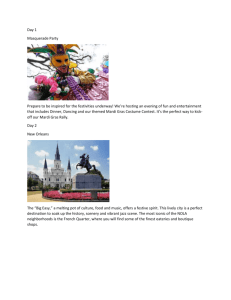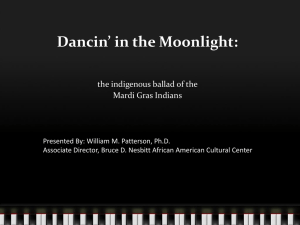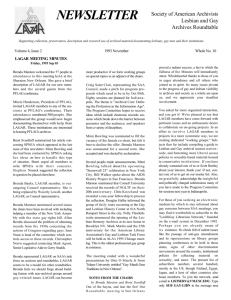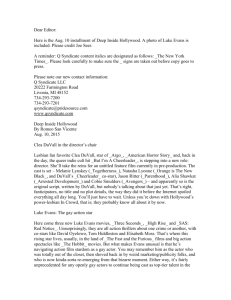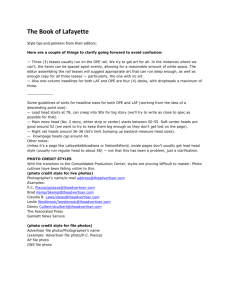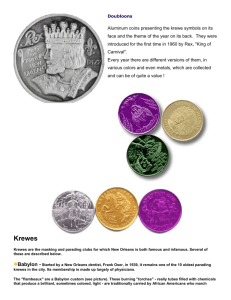Press Kit - First Run Features
advertisement
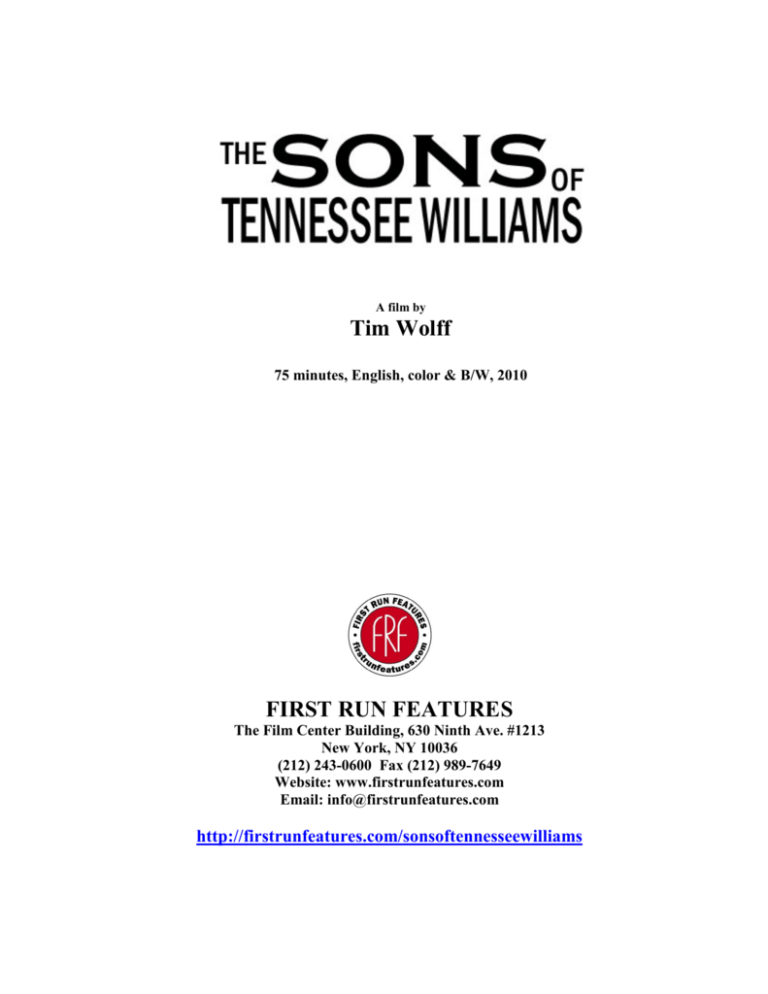
A film by Tim Wolff 75 minutes, English, color & B/W, 2010 FIRST RUN FEATURES The Film Center Building, 630 Ninth Ave. #1213 New York, NY 10036 (212) 243-0600 Fax (212) 989-7649 Website: www.firstrunfeatures.com Email: info@firstrunfeatures.com http://firstrunfeatures.com/sonsoftennesseewilliams “A lively tribute to the historical importance of the homosexual community to Louisiana’s most famous city.” — Elliot V. Kotek, Moving Pictures International Short Synopsis Mardi Gras, drag balls and politics–where else could these elements come together but in New Orleans? Interweaving archival footage and contemporary interviews, The Sons of Tennessee Williams charts the evolution of the gay Mardi Gras krewe scene over the decades, illuminating the ways in which its emergence was a seminal factor in the cause of gay liberation in the South. Long Synopsis The Sons of Tennessee Williams tells the story of the gay men of New Orleans who created a vast and fantastic culture of state chartered public "drag balls" in the early 1960s, pioneering the first gay civil rights in the US. They staged a flamboyant, costumed revolution without politics and won freedoms during a time, as now, when laws and people fought against them. Widely believed to be the catalyst that brought gay people out of hiding, the Stonewall riots of June, 1969 were the result of an ill-timed raid on the Stonewall Tavern in New York’s Greenwich Village. That story is well-known. In February 1959, a group of gay men in New Orleans decided to have a Mardi Gras ball of their own. Mardi Gras organizations in New Orleans, called krewes, are social clubs comprised of members who celebrate the season together. Each krewe has their own festivities, including parties and parades, usually ending with a formal ball and the coronation of a King and Queen. Everyone seems to have a krewe of some kind to belong to. A full decade before Stonewall, a gay Carnival krewe was founded. They called it the Krewe of YUGA or “KY”. In 1962, “KY” rented a school cafeteria in the notoriously conservative suburb of Jefferson Parish. Securing such a venue for an all male krewe to hold a Mardi Gras ball would not likely raise suspicion. Most krewes were, in fact, made up of an anonymous all male membership. Various personnel from the venue were present at functions like these, however. This would no longer be a private event. “It was a kindergarten, is what it was.” Familiar with police raids, the men knew that the 1962 ball would break a few laws. They made absolutely sure to be in full drag anyway. “It was a ball, after all, not bowling night.” The police roared in precisely at coronation time, alerted by private citizens of crossdressing men entering the building at night. Krewe members attempted to escape by running into the swamplands adjacent to the school, chased by officers with dogs and flashlights. Many were betrayed by their glittering costumes while hiding in the dark night and tall grasses of Jefferson Parish. They were taken to jail, identified by name in the newspaper and eventually prosecuted with the charge of “disturbing the peace.” The significance is this. The following year the ball was not raided nor was any subsequent ball in the history of these annual events. By 1969, there were four gay krewes legally chartered by the state of Louisiana as official Mardi Gras organizations, holding yearly extravaganzas at public venues across the city. “Society matrons begged for ball tickets from their hairdressers.” New Orleans was the first place in America where gay and straight people came together to publicly recognize gay culture. These men are the embodiment of the archetypal “southern bachelor gentleman,” complete with the cast-iron fortitude. Their story will reveal the pathos of the early persecutions and arrests to the uncommon freedoms in the decades that followed, as their political power began to emerge because of this culture. We will hear of AIDS emptying krewe rosters in the 1980s and eventually, the experiences during and after Katrina. They have more than a few stories to tell. Director’s Statement From the minute I walked into the Krewe of Petronius Ball in 1992, my first gay Mardi Gras ball experience, I couldn’t believe my eyes. I had seen quite of bit of gay culture in my day but this, this was like nothing I had ever seen. There were 3,000 gay men in tuxes milling around a giant ball floor at the civic center of the notoriously conservative St. Bernard Parish just outside of New Orleans. When the lights went down, well, that is where the magic began for me. The ball was loaded with tradition, yet, as I would soon see, extremely irreverent. The festivities opened with the national anthem followed immediately by the La Marseillaise. The costumes came out one by one, each more extravagant than the last. The concept behind the costuming is a sort of back mounted one-person float. They extend up and out to the sides as much as 8 feet or more. Most of the men struggle under the weight of the costume, even to move at all. Then, as is expected, they proceed to descend a ramp without assistance and parade endlessly back and forth to the ecstatic ovations of the ball guests, most of whom were on their feet. This continued for two hours. I was hooked by the spectacle, the pageantry, the tradition. I knew that night that I had found the subject of my first feature documentary, although it would take 18 years before it would come about. I then learned of the great history behind this culture. It began ten years before Stonewall. I was amazed that no one had heard of these accomplishments outside of New Orleans. The early pioneers of this culture had risked everything to participate in the annual festivities of Mardi Gras in the way of their choosing. It is customary to spend this most important of holidays with your dearest comrades. The first ball broke every anti-gay law on the books. They were finally raided in 1962 but never again in the 50 year history of the gay krewes. After the raid, they quickly learned to use the traditions of Carnival, the most permissive Catholic holiday, to their advantage. I was struck and impressed with their bravery and their cleverness, to approach the state for a legal charter for a gay carnival organization in 1963, providing themselves with protection from arrest. They accomplished primary civil rights without protest, without violence and in full drag. Katrina took everything from me, including the preproduction I had done for this movie. In fall of 2007, I decided to re-write the treatment for the movie that the storm had destroyed. I passed this along to a prominent gay gallery owner who in turn passed it along to the board of the J. B. Harter Charitable Trust, an arts foundation started by the estate of gay artist Burt Harter. Within days I had the first 30,000 dollars that allowed the production to begin. My best friend from my Calarts days coincidently wrote that same week that the Sony Corporation had offered him the use of several of their HD cinema cameras that he had used while acting as director of photography for Sky Captain and the World of Tomorrow. The momemtum I had lost before was with me again. I ended up with 120 hours of historical interview from some 20 of the Sons themselves, and incredible footage of the 40th anniversary of one of the oldest krewes, the Krewe of Armeinius. What you will see is the result of 2 years of searching for archival ball footage and still pictures. Thank god for the "vanity" factor. Despite the incredible loss of losing so many krewe members to AIDS and the damages from the flood waters, there was still plenty of such material and media for me to weave this story, without narration, which was my goal all along. This story is told by the men who lived it and no none else. I hope you will enjoy this microcosm of the American gay experience in the last half of the 20th century and appreciate the southern queens and the cast-iron fortitude that it has taken to prevail all through the years. Filmmaker Bios Producer/Writer/Editor/Director, Tim Wolff Tim Wolff received his education from the California Institute of the Arts Directing for Theatre and Film program, studying closely with director Alexander Mackendrick and twotime Oscar winning documentarian Terry Sanders. In 1999, he began the first of four productions at HBO as producer. He produced two segments for the popular HBO documentary show Real Sex with Wigstock: the movie filmmaker Barry Shils. This is his first feature documentary with Wolfhouse, Inc. Next up: The Ballad of Yes and No, a magical-realist musical comedy narrative feature. Director of Photography, Eric Adkins In 1987, Mr. Adkins received his BFA from California Institute of the Arts, in the live action film and video program. He now leads multiple production crews, from major live action shoots to stop motion sets. He is an active member of the American Society of Cinematographer's Technology Committee and has studied, tested and worked with many of today's high-end digital cameras. He began his career as lighting cameraman/cinematographer lighting both live action and stop- motion for film, television and commercials. In 1995, Eric began work as director of photography/ stop motion for director Tim Burton's film Mars Attacks! He was director of photography for 25 episodes of the Eddie Murphy written and produced series The PJ's. More recently he has served as VFX director of photography for over 44 episodes of the acclaimed series House, MD. His broad list of commercial clients as director of photography include Bacardi, ESPN, Coca Cola, Converse, FILA, Nintendo, Sony, Orange, Levi Strauss, Nabisco, Kellogg, Maynards, Orkin, Del Labs, Dow, Chase Manhattan, Southwest Bell, and US Postal Service. Then in 2004, his work as director of photography on the blockbuster Sky Captain and the World of Tomorrow identified Mr. Adkins as one of the world's preeminent HD cinematographers, particularly lighting and filming live subjects for HD motion pictures. This project had Mr. Adkins photographing Angelina Jolie, Gwenyth Paltrow and Jude Law with the breakthrough HD "film-less" technology. He was featured in both American Cinematographer and International Cinematographers Guild for his groundbreaking work. Second Unit Director of Photography/Co-editor, Matt Bucy Matt Bucy resides in White River Junction, Vermont, primarily working as a director of photography and editor on documentaries, short films and webisodes. His team recently won Best Picture and Best Cinematography in the 2010 Vermont 48 Hour Film Festival. His recent work includes The Sons of Tennessee Williams, three Star Trek Phase II webisodes, The Child, Kitumba and Origins, a behind-the-scenes documentary for the upcoming feature Judas Kiss, and the shorts The Tryout, Violin Case, Razor Burn and Dear Edward. Credits Producer, Writer, Director and Editor Director of Photography 2nd Unit Dir. of Photography/Co-Editor Additional Cameras Associate Producer Sound Camera Assistant Dolly Grip Additional Editing Production Staff TIM WOLFF ERIC ADKINS MATT BUCY BRAD BROOKS, FRANCIS JAMES PETER WEST CARL MOLLER PAUL GULIELMO CLAY THOMAS TIMOTHY WATSON GRAY GIBSON, ROBIN TURNER, DAVID MINSKY, WILLIAM ANDREWS, ANDREW WILLIAMSON, NICOLE DE LA ROSA, ASHLIE ANKENBRUCK Festival Appearances Frameline34/San Francisco Int'l LGBT Film Festival (rough cut premiere) June 27, 2010 Roxie Theatre The Tennessee WIlliams Theatre Festival (benefit for festival) July 18th, 2010 Provincetown MA Austin LGBT Film Festival September 15th, 2010, featured documentary Seattle LGBT Film Festival October, 2010 Palm Springs Int'l Film Festival January 10th and 14th, 2010 Select Press http://www.hollywoodreporter.com/review/sons-tennessee-williams-film-review-245764 The Sons of Tennessee Williams: Film Review 10/7/2011 by John DeFore The Bottom Line Genial doc combines extravagance of Mardi Gras drag with an underexposed story of early gay-rights achievements. Tim Wolff's documentary focuses on Mardi Gras with a story of early gay-rights achievements. Penning a new chapter in the history of gay-rights efforts, Tim Wolff's The Sons of Tennessee Williams offers Southern grace instead of the in-your-face conflicts of better-known showdowns on the East and West Coasts. A lack of stark drama in the story it tells will keep box-office prospects modest in a niche run, but a likeable combination of fresh perspective and Mardi Gras glamour should ensure warm reception on smaller screens. Interviewing 20 or so Louisiana men who struggled with mid-century attitudes toward gays, the movie recounts stings and raids in which police would round them up and the "TimesPicayune" would happily publish arrestees' names. Seeing Mardi Gras as the sole occasion on which flamboyance might be tolerated, a group of New Orleanians formed the all-gay Krewe of YUGA, hosting a private ball where men wore drag and played the parts of both King and Queen. That first ball was raided (providing some amusing tales of "women" who fled, seeking help from nearby families), but the fiasco triggered a campaign for formal recognition of the all-gay Mardi Gras "krewes" -- which soon flourished, years before New York's Stonewall riots. Making good use of vintage photos and other historical material, Wolff captures the vibrancy of their lavish parties, making it easy to understand why local straight socialites started begging for tickets. Wolff cuts back and forth from reminiscences of the tradition's early days to preparations for a 2008 ball celebrating 40 years of the Armeinius Krewe, which has survived AIDS, Katrina and the graying of its ranks. Here we see the laborious task of turning mountains of sequins, rhinestones and ostrich feathers into outfits a single wearer can hardly maneuver (for one, an 8-foot-wide urban skyline is attached to a man's back), and watch as a friendly group of lessthan-svelte gentlemen rehearse choreography commissioned for the anniversary. "Is it really a civil rights accomplishment for a man to wear a dress at the civic auditorium?" an interviewee asks at one point, acknowledging the spoofy roots of this movement. But for these men, a taste of public acceptance clearly served as welcome respite from police harassment, fratboy violence and familial rejection. http://blogs.villagevoice.com/dailymusto/2011/10/the_sons_of_ten.php The Sons Of Tennessee Williams Opens Tomorrow By Michael Musto Thu., Oct. 6 2011 No, the brilliant playwright didn't have children, unless you count Blanche DuBois and Stanley Kowalski (and I do). But his work and spirit have long loomed over the gay inhabitants of New Orleans, as captured in a new documentary opening tomorrow at the Quad. The doc remembers back to the time when just putting your hand on a same-sex person's knee could land you in jail, especially if the same-sex person was a cop. It also documents the incredibly creative gay community that arose in the face of this oppression, everyone dressing in full drag with skyscraping headdresses as they launched the eye-popping tradition known as the gay Mardi Gras. The movie is very sweet as it captures the heart and soul of what has become a sort of Boys Gone Wild As Girls parade. Do papa Tennessee a favor. Put on your Sunday clothes, top them off with three layers of feathers and bugle beads, and check out this movie's look at a class menagerie.
